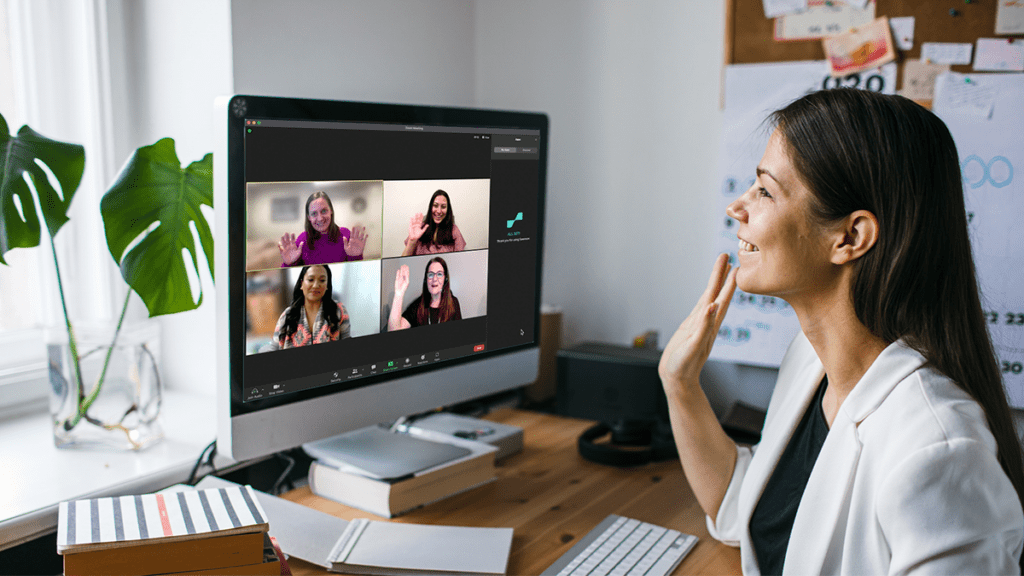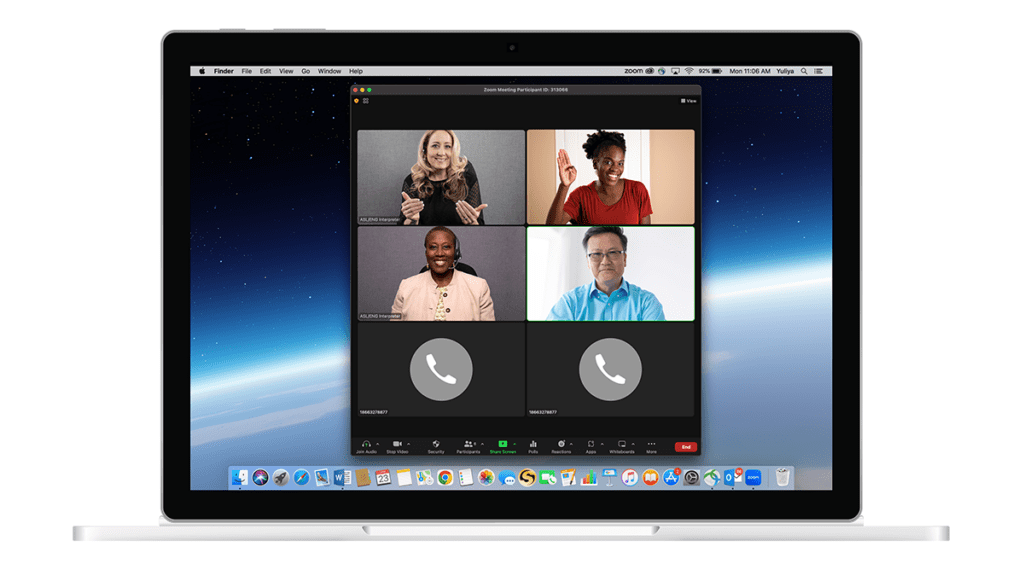How to Easily Make Zoom Meetings Deaf-Inclusive
The COVID-19 pandemic fueled a rapid rise in the use of tech in daily communication. And with a 55% share of the videoconferencing software market, Zoom — from Zoom Video Communications, Inc. — is the go-to for many businesses having virtual meetings. But using video relay service (VRS) to make Zoom usable for Deaf participants has lagged behind Zoom’s popularity—until now.
The History of Zoom for Deaf Participants
Zoom has a history of making accessibility a priority for users.
2013: The Zoom application became publicly available.
2020: Zoom added features for Deaf individuals who use American Sign Language (ASL) to more conveniently take part in Zoom meetings with non-ASL-fluent participants: the ability to pin more than one person’s video to the screen and rearranging attendees on the screen to give Deaf participants better visibility of an interpreter.
2021: Auto-generated Zoom captions for Deaf and hearing participants became available to any Zoom user. Captions had previously been limited to paid accounts and required the host to add on and pay for a third-party artificial intelligence (AI)-powered transcription service.
2022: Zoom added a Sign Language Interpretation view for paid accounts using the desktop client.
In the past few years, Zoom has made great strides in making meetings more Deaf-inclusive, but newer features and updates have restrictions and added steps for those wishing to use an ASL (American Sign Language) interpreter on Zoom.

Using VRS with Zoom for Sign Language Interpretation
In most cases, Zoom meetings with Deaf and hearing participants haven’t had interpreters present. Instead, many Deaf individuals have used video relay service (VRS) to get interpreting for those calls.
VRS is a no-cost interpreting service for Deaf people who use American Sign Language (ASL) to communicate through video calls on videophones, smart phones, tablets, or computers.
In Zoom meetings without an interpreter, Deaf participants have used VRS as a workaround. They call the meeting’s dial-in number on their VRS videophone or app, so the interpreter can connect to only the audio of the Zoom meeting.
Deaf individuals have used their VRS accounts this way for years for Zoom, but it’s not user- or Deaf-friendly:
- Deaf participants have to look back and forth between the screen with the interpreter and the separate screen with the Zoom meeting. This means they can potentially miss words, expressions, and shared screens. And it can be exhausting!
- The interpreter can only hear the audio of the meeting. They can’t see the video side of the conversation. Without the visual and emotional cues essential to sign language, both the interpreter and Deaf participant can’t get the full context of the meeting.

Integrated, On-Demand Interpreting through Zoom
Finally, the frustration was put to an end in 2023. Zoom users received a groundbreaking solution that solved for on-demand sign language interpreting in Zoom meetings. The update allows you to use a third-party app to pull an interpreter directly into your Zoom meeting as a participant with a couple clicks for a more convenient and inclusive experience. Then, everyone can see each other, the interpreter, and shared screens on one device in one window. Since hearing participants also see the interpreter, they can allow time for the interpreter to sign and see when a Deaf participant has something to add.
The interpreter can also see everyone on the call and access all Zoom features, including seeing a shared screen and speakers’ names. This helps them to easily identify speakers and convey unspoken context.
The two options for accessing this integrated, on-demand interpreting both connect users to expert interpreters for English to ASL or Spanish to ASL interpretation:
Sorenson for VRS for Zoom is an option for Deaf individuals to use their personal VRS accounts for school, business calls, or calling friends and family.
Sorenson Express for Zoom is an enterprise solution to access on-demand video remote interpreting (VRI) for impromptu meetings and last-minute interpreting needs.
VRS and VRI both connect calls over a high-speed internet connection via a video conferencing platform, but they serve different purposes and users. You can read more about the differences here: What is Video Relay Service (VRS)
Sorenson for Zoom VRS: a Simpler Way to Use an ASL Interpreter on Zoom
In March 2023, Sorenson — the leading provider of VRS — released two better ways of using Zoom with VRS: a web app and an integrated Zoom app. Sorenson is the first to deliver VRS-based solutions that remove the need for a cumbersome workaround for Deaf and hearing attendees to communicate in Zoom meetings.
As long as the meeting host has a paid Zoom account, anyone who has a Sorenson Video Relay account — whether they are the host or a participant — can use the Sorenson Express for Zoom web app to add an on-demand ASL interpreter to their Zoom meeting. A meeting host can also add an interpreter during meetings with the integrated Zoom plug-in. Everyone can then see the interpreter right in the meeting with everyone else. There’s no need to use two devices for a single meeting.
If you’re a Deaf business owner, Sorenson for Zoom is even available for calling your clients or taking appointments. However, this integration isn’t suitable for all workplace scenarios:
- VRS isn’t available for webinars because of the need for Deaf users to remain on camera.
- It’s not ideal for meetings with multiple Deaf attendees because if the person using their VRS account must leave the meeting, everyone loses the interpreter.
Sorenson Express for Zoom: On-demand Interpreting for Businesses
Video Remote Interpreting (VRI) is a well-established interpreting solution for virtual and in person conversations. Scheduled VRI is an ideal solution when you know you’ll need an interpreter ahead of time because it allows for interpreter assignment to meet your specific needs. It’s not, however, appropriate for impromptu communication.
The introduction of Sorenson Express in May 2023 introduced flexible, on-demand VRI that gives account-holders access to a mobile device-based interpreting option for face-to-face interaction and videoconferencing app integrations for unplanned meetings.
Sorenson Express for Zoom is a VRI integration that offers a business or organization on-demand, seamless communication between Deaf and hearing employees or clients in virtual meetings. Businesses with a Sorenson Express account can access interpreting through the Zoom integration as well as on a tablet for in-person conversations.
Users can access Sorenson Express for Zoom through a built-in app from the Zoom marketplace or Sorenson’s web app.
When to Choose the Zoom App vs the Web App
Whether using Sorenson’s VRS or VRI solutions for Zoom ASL interpretation, users can invite an interpreter from an app in Zoom or a web-based Sorenson app. Your situation and preferences will determine which to choose.
Sorenson for Zoom VRS
You can use the web app:
- if you are a Zoom meeting host or an attendee.
- if the meeting host has a paid Zoom license.
- if you are eligible and registered for Sorenson VRS.
- without downloading anything to your device.
- You can use the Zoom app found in the Zoom marketplace if you:
- are the Zoom meeting host.
- have a paid Zoom license.
- use a Mac or PC and have permission to download and install apps.
Sorenson Express for Zoom on-demand VRI
You can use the web app:
- if you are the Zoom meeting host or an attendee.
- if you are registered for Sorenson VRI.
- without downloading anything to your device.
You can use the Zoom app found in the Zoom marketplace if you:
- are the Zoom meeting host.
- are registered for Sorenson VRI.
- use a Mac or PC and have permission to download and install apps.
Try Sorenson Solutions for Multilingual Communication and Workplace Inclusion on Zoom Meetings
Effective communication and Deaf accommodations in the workplace and beyond don’t need to be difficult. When you need an ASL interpreter on Zoom, Sorenson’s integrations for businesses and Deaf individuals empower inclusive meetings for work, school, and everyday interaction. For true workplace inclusion, the range of accessible communication services available from Sorenson.

